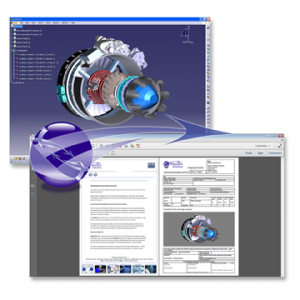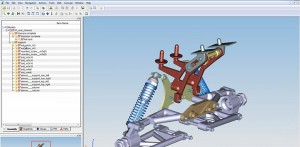
Archive for the ‘Uncategorized’ Category
Tuesday, December 8th, 2015
Theorem’s Publish 3D suite of products enable the publishing of 3D CAD data directly from within design applications and visualization data using batch processing to interactive 3D PDF documents. The published 3D PDF document output contains embedded interactive 3D representations of the native CAD data (within a pre-defined template).
Publish 3D products support the processing of Model Based Definition (MBD) information when publishing 3D PDF documents from native CAD and visualization data. 3D annotations, dimensions (PMI/FTA/GD&T), assembly structure, geometry, views, and attribute data (where available) are published to the 3D PDF document at the point of creation helping to streamline the design and manufacturing process into a paper free digital process.
Publishing an information rich 3D CAD model to a 3D PDF document that fully defines the product and provides specifications, for both parts and assemblies, helps to remove the need for associated paper documents saving time, resource and potential risk of error.

3D PDF’s have the capability to be interrogated, marked-up and annotated, and can also act as a ‘carrier’ file for additional data to be transported (such as spreadsheets, images AVI Movies, hyperlinks, as well as native CAD data), creating a richer file and source of information reducing ambiguity.
Using Publish 3D with associated MBD processing information is the best approach to define and communicate engineering product component data, and sharing the information using interactive 3D PDF documentation makes it more accessible and consumable throughout the manufacturing process by anyone who has access to Adobe Reader.
(more…)
No Comments »
Wednesday, November 25th, 2015
Theorem Solutions recently released Unified Interface (UI), which supersedes Theorem’s CADviewer and UI products, has been specifically developed to optimise both data exchange and downstream processes using a single application that can be used to view, filter, translate and even publish interactive documentation from native 3D CAD data.
Incorporating all elements required for successful data exchange Theorem’s new UI extends its use past the bounds of engineering departments to other departments who will also benefit from access to the new UI.
Included within certain Theorem CADverter, Publish 3D and Visualize 3D product suites, Theorem’s unified interface can be configured to suit a number of use cases and individual user types: a productivity tool for engineering users, and as a viewing and publishing tool for other users.
(more…)
Tags: CADverter, Product Structure Viewer, Publish 3D, Publishing, Translation, Unified Interface, Visualize 3D
No Comments »
Wednesday, November 11th, 2015
When working with different suppliers as part of the design and manufacturing process, there will always be a requirement to exchange design data back and forth. However, the CAD systems used by different suppliers may be different to the ones you use.
So how do you go about exchanging data if it’s in a different format?
Theorem CADverter products offer the capability to receive, create, work with or share CAD data that is not native to your own company. CADverter allows direct translation between many of the major CAD systems as well as standards based formats such as STEP.
The latest CADverter range of products from Theorem now support the processing of Model Based Definition (MBD) information as standard.
This is helping to streamline the manufacturing process into a paper free process by producing an information rich 3D CAD model that fully defines a product/component ready for manufacture.
CADverter products translate assembly structure, geometry, attribute, and where available 3D Product Manufacturing Information (PMI) (FTA) (GD&T) and Metadata between CAD systems. As modern 3D CAD applications allow for the insertion of 3D dimensions and annotations, as well as other product information within the 3D digital data set, for both components and assemblies, the risk of error is greatly reduced as all information required to manufacture is also translated to the new format helping to remove the need for the more traditional 2D drawing creation process.
(more…)
Tags: CAD, CADverter, FTA, GD&T, Intellectual Property protection, MBD, Model Based Definition, PMI, STEP, Translation
No Comments »
Wednesday, November 4th, 2015
Theorem Solutions recently ran a 5 minute presentation on the benefits of 3D PDF.
If you missed it you can download it here
It’s a little known fact that using interactive 3D PDF documentation improves the quality of internal and external communications. Utilising your existing technology, you can create incredibly rich documents by embedding 3D models into existing PDF files that can be read by anyone with a PC, laptop, tablet or smartphone as long as they have access to the ubiquitous Adobe Reader.
Using the Adobe toolbar, you can manipulate and view the data in a way that is applicable to you. The 3D PDF has the capability for the document to be annotated and can also act as a ‘carrier’ file for additional data to be transported (such as spreadsheets, AVI Movies, hyperlinks, as well as native CAD data) to create a richer file and source of information.
(more…)
Tags: 3D PDF, 3D Publishing, Adobe
No Comments »
Tuesday, November 3rd, 2015
Over the years, engineers and designers have embraced new technologies such as CAD/ CAM systems to develop products and ideas that have changed the way we live. As CAD systems evolve, some of these technologies become outdated, but the data produced can still have a relevance and may need to be accessed for possibly many years to come.
So when the technology becomes outdated, how do you preserve its data output and carry it forward?
Theorem’s Process Automation services offer tailored and automated legacy migration solutions that enable you to seamlessly transfer legacy data to your new system, whilst helping to manage the execution of data migration tasks, automating repetitive tasks and utilising available hardware and software resources.
(more…)
Tags: 3D CAD PMI, BOM Data, CAD Data, Data Migration, engineering productivity, Geometry, legacy data, manufacturing data, Product structure, Visualization data
No Comments »
Monday, November 2nd, 2015
As modern 3D CAD applications allow for the creation of 3D dimensions and annotations (PMI/FTA/GD&T) along with multiple model views and layouts and other product information within the 3D CAD data set for both components and assemblies, the risk of error is greatly reduced. Now that all of the product definition information can be created using these 3D Model Based Definition (MBD) methods, an alternative and completely digital method replacing the traditional 2D drawing creation process is achievable.
Theorem’s Visualize 3D and Publish 3D suite of products, along with the latest versions of CADverter and Multi-CAD provide improved support for information supporting the Model Based Definition (MBD) process, helping to streamline manufacturing into a paper free process by publishing an information rich 3D CAD model that fully defines a product.
(more…)
Tags: 3D Dimensions and Annotations, CADverter, Engineering. Manufacturing, FTA, G D &T, Model Based Definition, Multi-CAD, PMI, Publish 3D, Visualise 3D
No Comments »
Tuesday, October 27th, 2015
Due to the nature of design in manufacturing companies, there is no one standard CAD, Visualization or Publishing system. Manufacturers and their supply chains often have different systems in place, sometimes within the same four walls of the company. Each of these has particular nuances and they store their design information in widely differing formats.
Theorem’s extensive product portfolio has undergone a complete rebrand with a view to differentiate products into new families that simplify and streamline the process for the user to select the correct solution for their needs, whether that’s CAD to CAD, CAD to STEP, CAD to Visualization or CAD to Publishing.
As technology has evolved and the performance capabilities of computers has dramatically improved, it has enabled a much wider set of use cases and applications to be commercially and technically viable. However, these different use cases and applications require different types of 3D data in order to work. Sometimes the differences in the 3D data are subtle, in other cases the differences are significant.
(more…)
Tags: CAD, CADverter, Data Translation, Multi-CAD, Process Automation, Publish 3D, Publishing, STEP, Visualise 3D
No Comments »
Wednesday, October 21st, 2015
Theorem Solutions are hosting a seminar covering the topic: Using 3D PDF in Engineering and Manufacturing at the Manufacturing Technology Centre (MTC) in Coventry, UK on Wednesday 11th November 2015.
The focus of the seminar is to discuss the emerging use of the 3D PDF format within an organisation and throughout their supply chains and how using the 3D PDF document format can revolutionise this process.
Sharing CAD design data usually requires the recipient to have access to the relevant CAD system and an understanding of how to read the data. This however, is not always the case, especially when data needs to be shared between non-engineering/design related departments.
(more…)
Tags: 3D PDF, Embedded 3D models, Interactive 3D PDF, Publish 3D
No Comments »
Monday, September 28th, 2015
When developing large and complex products such as cars or aeroplanes, you can be faced with the need to use numerous CAD systems in-house, on a single product design and manufacturing task
Whilst this design process may be an efficient way to manufacture these types of products it can cause problems when the CAD data needs to be exchanged by those involved in the design process who may not be using the same CAD software. CAD to CAD and CAD to Visualization translators are available, but what if the OEM uses CATIA but needs to also access CAD data from NX, CREO or JT systems directly from within their CATIA design environment without the need for external translation tools?

Theorem have come up with a Multi-CAD solution that allows designers and engineers to do just that. Based upon the Dassault Systemes XCAD infrastructure, it allows CATIA V5 users to incorporate parts and assemblies from the other CAD systems, such as NX and Creo, within the CATIA environment without having to use external translators. It pulls the files directly into CATIA and uses the existing V5 commands of “Insert existing component”, “file open” and “file save as”. It then checks the geometry for errors and validates the integrity of the data as it comes into CATIA. The beauty of the solution is the interlinking of the CATIA and foreign CAD data.
(more…)
Tags: CATIA, Dassault Systemes, JT, Multi-CAD, multi-CAD application design, PTC Creo, Siemens NX, XCAD infrastructure
No Comments »
Wednesday, September 23rd, 2015
In every product lifecycle process design data and product information need to be shared. Almost every department within an organisation (with the exceptions of HR and Accounting) will need to discuss the product with someone at some point along the process, whether it’s with another department or external suppliers.
It used to be that engineers who designed products in CAD systems would struggle to share the CAD data with those in other departments, as specialist training and software systems would often be needed, which could be expensive, but the ability to share 3D product data with non CAD users both internally and externally is important because it reduces ambiguity and therefore aids communication.
Most of us are familiar with receiving documents in a PDF format, such as phone bills, tickets and brochures, and then viewing them in Adobe Reader, which is installed on pretty much every device as standard. So why not find a way to send the CAD data in a similar format that is as easily accessible?
(more…)
Tags: 3D CAD data, 3D PDF, Adobe Acrobat, Design, Engineering, Intellectual Property protection, Publish 3D, Supply Chain Collaboration
No Comments »
|









